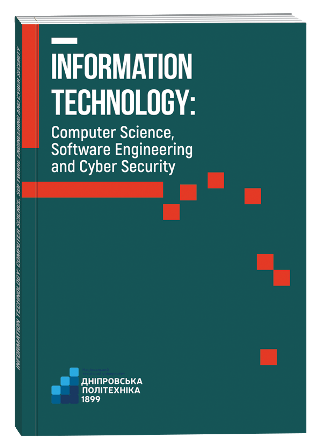METHODS OF REPRESENTATION OF 3D OBJECTS FOR LEARNING GENERATIVE NEURAL NETWORKS
DOI:
https://doi.org/10.32782/IT/2024-1-8Keywords:
three-dimensional objects, DCGAN models, generative neural network models, generative competitive networks, variational autoencoders.Abstract
The paper considered various methods of three-dimensional objects generating by using of neural networks. Several key elements of the methodologies of this type of synthesis of new information were singled out, on the basis of which a new way of three-dimensional objects representing was proposed for its use for typical generative models of neural networks training. The purpose of the work is to develop a method of representing of three-dimensional objects that would satisfy the criterion of high density of information useful for a generative model. The minimization of the redundancy of the information generated together with the minimization of the losses associated with the process of transition from a three-dimensional way of representing of an object to a two-dimensional one (with which the existing generative models can cope quite well) are the key aspects of the proposed method of representation. The methodology for solving of the problem given consists in building of a mathematical model of a new type of representation of three-dimensional objects; development of a software algorithm that implements a mathematical model; and testing this representation based on a typical generative neural network model. The scientific novelty is that for the first time such a type of representation of a three-dimensional object was proposed, which could be used for typical generative models training. Conclusions. The proposed method of representing of a three-dimensional object showed its viability even in the context of training of a small typical generative model DCGAN. Prospects for further research of the proposed method for training of other typical generative models were also determined, because this method could be quite easily adapted to representations of input and output data of a wide range of neural network architectures.
References
Ian, J. Goodfellow, Jean Pouget-Abadie, Mehdi Mirza, Bing Xu, David Warde-Farley, Sherjil Ozair, Aaron Courville, Yoshua Bengio. Generative Adversarial Nets. Archive of scientific articles arXiv, 9 p. arXiv: 2014. 1406.2661.
Description of the working principle of the VAE model. Medium WebSite. URL: https://towardsdatascience.com/understanding-variational -autoencoders-vaes-f70510919f73.
A general description of the existing methods of presenting three-dimensional models. Carlow Institute of Technology website, Ireland. URL: https://glasnost.itcarlow.ie/~powerk/GeneralGraphicsNotes /meshes/polygon_meshes.html.
Description of the most popular file formats for 3D objects. SelfCAD project site. URL: https://www.selfcad.com/blog/8-best-common-3d-file-formats.
Official documentation for Universal Scene Description. URL: https://openusd.org/release/index.html.
Jiajun, Wu, Chengkai, Zhang, Tianfan, Xue, William, T. Freeman, Joshua B. Tenenbaum. Learning a Probabilistic Latent Space of Object Shapes via 3D Generative-Adversarial Modeling. Archive of scientific articles arXiv, 2017. 11 p. arXiv: 1610.07584.
Charlie, Nash. The shape variational autoencoder: A deep generative model of part-segmented 3D objects. Charlie Nash, C. K. I. Williams. – GitHub website of article author Charlie Nash, 2017. 11 p. URL: http://charlienash.github.io /assets/docs /sgp2017.pdf.
AtlasNet: A Papier-Mache Approach to Learning 3D Surface Generation. Thibault Groueix, Matthew Fisher, Vladimir G. Kim, Bryan C. Russell, Mathieu Aubry. – Archive of scientific articles arXiv, 2018. – 16 p. arXiv: 1802.05384.
Matheus Gadelha. Multiresolution Tree Networks for 3D Point Cloud Processing. / Matheus Gadelha, Rui Wang, Subhransu Maji. – Archive of scientific articles arXiv, 2018. – 17 p. arXiv: 1807.03520.
PointFlow: 3D Point Cloud Generation with Continuous Normalizing Flows. Guandao Yang, Xun Huang, Zekun Hao, Ming-Yu Liu, Serge Belongie, Bharath Hariharan. – Archive of scientific articles arXiv, 2019. – 15 p. arXiv: 1906.12320.
Learning Representations and Generative Models for 3D Point Clouds. Panos Achlioptas, Olga Diamanti, Ioannis Mitliagkas, Leonidas Guibas. – Archive of scientific articles arXiv, 2018. – 18 p. arXiv: 1707.02392.
PolyGen: An Autoregressive Generative Model of 3D Meshes. Charlie Nash, Yaroslav Ganin, S. M. Ali Eslami, Peter W. Battaglia. – Archive of scientific articles arXiv, 2020. – 16 p. arXiv: 2002.10880.
Occupancy Networks: Learning 3D Reconstruction in Function Space. Lars Mescheder, Michael Oechsle, Michael Niemeyer, Sebastian Nowozin, Andreas Geiger. – Archive of scientific articles arXiv, 2019. – 11 p. arXiv: 1812.03828.
Comparison of different configurations of the GAN model based on the AWS cloud computing service. Information Technology: Computer Science, Software Engineering and Cyber Security. B. Moroz., L. Kabak, K. Rodna, E. Ruksov, 2, 2022. p. 61–78. https://doi.org/10.32782/IT/2022-2-7.







